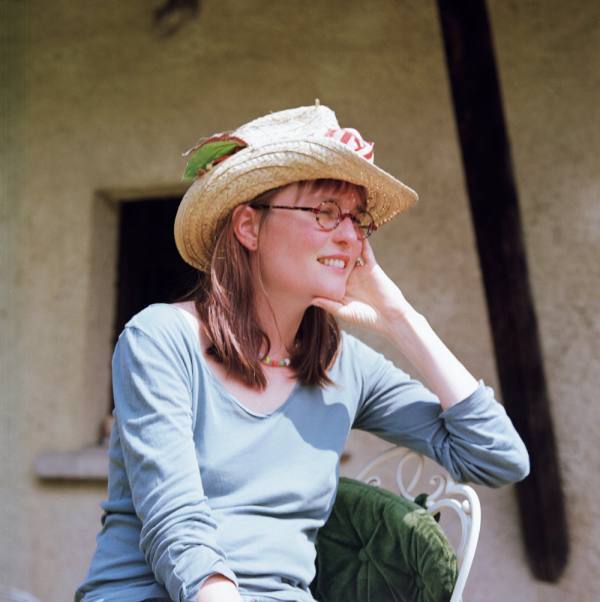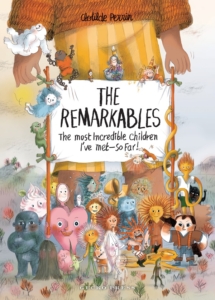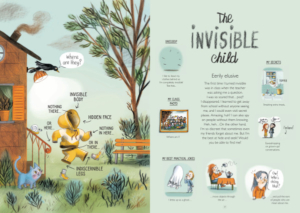
An interview with the remarkable Clotilde Perrin
With over 30 books to her name, French author and illustrator Clotilde Perrin is celebrated for her intricate, interactive storytelling and her books invite readers into worlds filled with playfulness and a touch of the macabre. Her latest with Gecko Press, The Remarkables, which features 40 extraordinary imaginary young people, shifts focus to celebrate children’s unique traits and quirks, capturing the essence of individuality. Mat Tobin spoke to Clotilde about her inspirations, her creative process, and the importance of giving children the space and time to embrace their own superpowers.
 ‘I’ve met so many children in my travels – each one so different, and in their own way, remarkable!’ Clotilde describes how she wanted to capture that sense of uniqueness in The Remarkables, to exaggerate real traits and turn them into superpowers. So the child who can’t sit still becomes the Springy child, always bouncing, while the one with a wild imagination transforms into the Scribbly child. It’s a way of celebrating those traits that make us who we are. ‘As a child, I felt very much like the Grassy Child – quiet, deeply rooted in nature, always flourishing in my own little world. But now, I think I’m more like the Scribbly Child. My ideas are always bouncing around, and I’m constantly creating. I suspect that’s what keeps me moving forward with each new project.’
‘I’ve met so many children in my travels – each one so different, and in their own way, remarkable!’ Clotilde describes how she wanted to capture that sense of uniqueness in The Remarkables, to exaggerate real traits and turn them into superpowers. So the child who can’t sit still becomes the Springy child, always bouncing, while the one with a wild imagination transforms into the Scribbly child. It’s a way of celebrating those traits that make us who we are. ‘As a child, I felt very much like the Grassy Child – quiet, deeply rooted in nature, always flourishing in my own little world. But now, I think I’m more like the Scribbly Child. My ideas are always bouncing around, and I’m constantly creating. I suspect that’s what keeps me moving forward with each new project.’
While her earlier works, such as Inside the Villains, Gotcha and The House of Madame M, embraced darker, more sinister themes, Clotilde notes that the shift toward celebrating children’s individuality in The Remarkables felt like a natural progression. However, she still believes that darker themes play an important role in children’s literature. ‘There’s something powerful about letting children confront their fears in a book. They can close the book when it gets too much, and return to it when they feel ready, giving them control over what scares them.’
This balance between light and shadow is something Clotilde has always appreciated in the works of Maurice Sendak and Edward Gorey, both  of whom continue to inspire her. ‘When I rediscovered Gorey as an adult, I was struck by how his books are perfectly suited for both adults and children. That moment was very important for me – I wanted to make books with that same depth and dimension, where there is always something more to uncover with each reading: a book with layers of meaning.’ She adds, ‘A book for children must be clever and elegant—something that speaks to both the young reader and the adult, offering something new with each revisit.’
of whom continue to inspire her. ‘When I rediscovered Gorey as an adult, I was struck by how his books are perfectly suited for both adults and children. That moment was very important for me – I wanted to make books with that same depth and dimension, where there is always something more to uncover with each reading: a book with layers of meaning.’ She adds, ‘A book for children must be clever and elegant—something that speaks to both the young reader and the adult, offering something new with each revisit.’
This focus on engaging both adults and children led Clotilde to consciously include parents in The Remarkables, the first time she’s done this in a book. ‘You’ll find adults alongside their children throughout the book,’ she explains. ‘I wanted parents to pick up on little jokes that might initially go over a child’s head, but could be appreciated more as they grow.’
The Remarkables also stands out for its playful, non-linear format. Clotilde explains that she wanted the book to be experienced in an unstructured way, where readers can jump from page to page, discovering something new each time. ‘It’s not meant to be read in one sitting or in a specific order,’ she says. ‘Instead, the book invites readers to flit through its pages, enjoying the humour and hidden details.’ This required careful planning, as Clotilde would often shift and reorder the children, looking for ways to connect their stories or group those with similar traits together.
 Clotilde and I also share an admiration for translator Daniel Hahn, who has worked with Gecko on several of her books, including The Remarkables. Clotilde praises Danny’s ability to preserve the playfulness and nuance of the original French texts, showcasing his own superpower. He captures the essence of her work while ensuring that the English versions maintain a rich and engaging vocabulary, inviting young readers to explore words they might not already know. ‘Danny has this wonderful way of choosing the right words for humour while also keeping the richness of language intact,’ Clotilde notes. ‘It’s not just a translation – it’s a careful crafting of tone, vocabulary, and playfulness that matches the original but also makes something new from it.’
Clotilde and I also share an admiration for translator Daniel Hahn, who has worked with Gecko on several of her books, including The Remarkables. Clotilde praises Danny’s ability to preserve the playfulness and nuance of the original French texts, showcasing his own superpower. He captures the essence of her work while ensuring that the English versions maintain a rich and engaging vocabulary, inviting young readers to explore words they might not already know. ‘Danny has this wonderful way of choosing the right words for humour while also keeping the richness of language intact,’ Clotilde notes. ‘It’s not just a translation – it’s a careful crafting of tone, vocabulary, and playfulness that matches the original but also makes something new from it.’
One example Clotilde particularly enjoys is Danny’s use of parentheses when describing the (very shy) Hairy Child, which adds an extra layer of English humour. ‘That small touch perfectly captures the sense of wanting to stay hidden and private,’ she says, highlighting how carefully Danny works to mirror the subtleties of the original language in ways that resonate with an English-speaking audience. This use of parentheses wasn’t present in the French version, making it a brilliant addition that deepens the character’s shy, reclusive nature for English readers.
Growing up in a quiet environment, Clotilde reflects on how her surroundings allowed her imagination to flourish. ‘There wasn’t much to do, so I spent hours sketching and observing. The ideas for my stories would come from the simplest things – a tree, a shadow, or the way the light hit something.’ She recalls her childhood home being nestled in a landscape where time seemed to move slowly, surrounded by fields and woodlands. ‘There was space to get lost in thought,’ she says. The woods were especially important—magical places where Clotilde might encounter, through her imagination, the fey as well as the fearful. These moments helped nurture a creativity that continues to flourish.
She believes that this sense of creative wandering is something children today still need. ‘Boredom is when children start to invent and create,’ she says, stressing the importance of giving children time to let their imagination run wild. ‘In The Remarkables, each child creates their own world, and their superpowers come from that sense of individuality. Sometimes, our best stories come from those quiet moments when the mind is free to explore.’
Clotilde also shares insights into her process, explaining how she laid out each child’s story in The Remarkables as a storyboard. She would  move the pieces around, looking for ways that their individual stories might connect or overlap. ‘The storyboard is essential for me,’ she explains. ‘It’s where I see how the children’s worlds come together, even though each one is unique.’ One of the most important spreads in the book, she adds, is the one where all the children’s homes are displayed. ‘I want children to see that image and know that it’s real—because to me, it is real.’
move the pieces around, looking for ways that their individual stories might connect or overlap. ‘The storyboard is essential for me,’ she explains. ‘It’s where I see how the children’s worlds come together, even though each one is unique.’ One of the most important spreads in the book, she adds, is the one where all the children’s homes are displayed. ‘I want children to see that image and know that it’s real—because to me, it is real.’
Over the years, Clotilde’s creative process has evolved, particularly in balancing the intricate visual elements of her books with the narrative flow. She explains that experimenting with different mediums, such as ceramics and paper engineering, has not only enriched her storytelling but also encouraged her to take creative risks. ‘I like putting myself in danger,’ she says, referring to the bold choices that can lead to unexpected discoveries. Working with clay, for example, has helped her embrace imperfections in her work. ‘When you have a fault, when it’s not perfect, it’s better—you learn something from it.’ These moments of imperfection, she notes, are where true creativity flourishes. ‘I’m always trying to push myself creatively, whether it’s through a new format or a different technique, because with uncertainty comes the possibility of surprise.’
Looking ahead, Clotilde is excited about her upcoming projects, including working on another ‘lift-the-flap’ book, this time centred around the disagreements between neighbours living in the same house who eventually build a wall to separate themselves. ‘It’s a bit of a reflection on how we create divisions, but playfully and engagingly,’ she explains. ‘There’s still a lot of work to be done, but I think readers will love it.’
For Clotilde, the world of stories always begins with a sketchbook in hand. She points out that she appears within the pages of The Remarkables not only as the Scribbly Child, with ideas constantly swirling, ready to be captured, but also as herself, leading the children into the book on the endpapers and in the introduction. Her books are an invitation for children to step into these carefully crafted, intricate worlds, where their imaginations can roam free. And with each new book, she offers readers the chance to find a bit of themselves in her stories and to discover magic in the everyday.
Mathew Tobin is a Senior Lecturer in Primary English and Children’s Literature. His co-authored book, Teaching and Understanding Primary English, is published by Sage Publishing, 9781526426598, £24.99.
The Remarkables by Clotilde Perrin is published by Gecko Press, 978-1776575046, £20.00 hbk.





